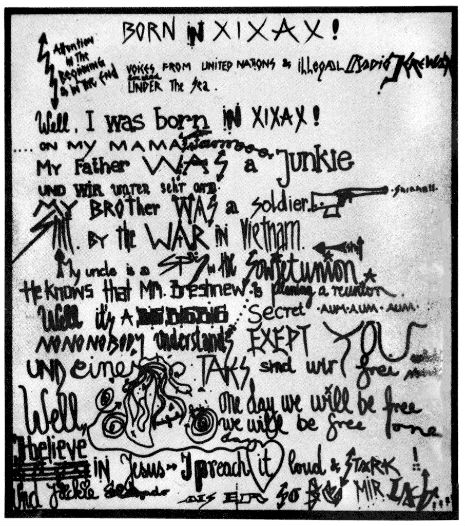
Nina Hagen’s 1982 album NunSexMonkRock is one of the single most ground-breaking and far-out things ever recorded and it deserves to be considered a great—perhaps the very greatest—unsung masterpiece of the post-punk era.
I’ll take it even further: To my mind, it’s on the same level as PiL’s Metal Box, Captain Beefheart’s Trout Mask Replica or Brian Eno and David Byrne’s My Life in the Bush of Ghosts. Or The Dreaming by Kate Bush.
There I’ve said it.
Make no mistake about it, artistically NunSexMonkRock is a monumentally important recording.
It’s also something you can buy used for a single penny on Amazon. There is no mention whatsoever of the album in Simon Reynolds’ Rip It Up and Start Again: Postpunk 1978-1984. The Allmusic review of NunSexMonkRock is but a single sentence. The Quietus doesn’t give a shit about it, nor does The Wire. In fact, there is almost nothing of any substance written about the album online anywhere. Hardly any music blogs have ever deigned to even mention it. Google the title, you’ll see what I’m talking about.
That doesn’t mean that NunSexMonkRock doesn’t have its hard-core passionate admirers—there are dozens of Amazon reviews and almost all of them are five-star raves—but we’re talking about something that was obscure 40 years ago when it came out. Even if you could easily pick it up at the local mall then—and for a while there, you could—few did. I would imagine that most people who have discovered the charms of NunSexMonkRock since it was first released have done so primarily because they saw it in a $1 bargain bin and it looked weird so they picked it up. (Every used copy of NunSexMonkRock on vinyl is pristine, it’s virtually guaranteed.)

Luckily for both of us, you don’t have to take my word for any of this, I can make my case for the epic holy/demonic genius of NunSexMonkRock with the music itself—thanks YouTube—which is neither wholly punk, nor rock, nor opera, nor really anything even remotely recognizable as any previously known genre of music. Already a category of one, NunSexMonkRock appears to have no obvious influences either. Reliable adjectives fall by the wayside when you are confronted with such an anarchic artistic anomaly. Because it’s so very much out on its own peculiar limb, it’s completely timeless. (Musically at least, but lyrically Hagen makes a cryptic prophecy about the then leader of the Soviet Union, Leonid Brezhnev, who up and died the year the album came out.) NunSexMonkRock could have been recorded 40 years ago, yesterday, or a thousand years from now and it just wouldn’t matter.
The album inhabits a territory so utterly exotic and unclassifiable that the creator herself would never again venture that far out. NunSexMonkRock is a zany, oddball, sexy, freaky as fuck and totally revolutionary masterpiece of modern music. At the center of this evil maelstrom is Hagen’s multi-layered, multi-octave and gymnastically operatic voice, a unique hybrid of Maria Callas, Zarah Leander, Yma Sumac and Mercedes McCambridge doing the voice of the demon Pazuzu in The Exorcist...
Rolling Stone called NunSexMonkRock the “most unlistenable” album ever made. Au contraire. It’s an incredibly weird album, let there be no doubt about THAT, but once you’ve gotten over the initial shock, NunSexMonkRock is as catchy as hell. “Most unlistenable”? Although that sounds like a dare I personally would be willing to take Rolling Stone up on, it’s not even remotely true.

Nevertheless(!), let’s ease into it, shall we, and start off with what is probably NunSexMonkRock‘s most accessible number, the unstoppable riff-driven rocker “Born in Xixax” that leads off side two of the album. This features the great Chris Spedding on guitar. Tell me this riff isn’t as good as “All Day and All of the Night” or “Jumping Jack Flash.”
“This is Radio Yerevan and this is the news…”
Okay, so if “Born in Xixax” is the most accessible way to ease into NunSexMonkRock, then “Smack Jack” is probably the best-known number from the album. This extraordinarily frenzied anti-drug rant addressed a topic Hagen herself knew well about, as she had a high-profile romance with Dutch rocker Herman Brood, the Netherlands’ most famous junkie.
“Smack Jack” went to #7 in Norway in 1982, believe it or not.
A word about the players on the album. Aside from the aforementioned Chris Spedding, none other than David Letterman’s sidekick Paul Shaffer (a top session player of that era) was on keyboards. Another contributor was Paul Roessler, a synthesizer player who was once a member of the legendary Screamers. There was ace studio drummer Allan Schwartzberg (once of Mountain) and Karl Rucker, who played with Hagen for some time, on bass. With the studio pros providing a solid backbone, the weirdos—Roessler, Rucker and Hagen—had a canvas to run wild over.
But NunSexMonkRock is also, I think quite obviously, a producer’s album and Mike Thorne was the George Martin figure who was absolutely necessary to pull this grandiose, multi-tracked, borderline insane vision together. (EVERY song on the album, it should be noted, makes “I Am The Walrus” seem as simple as a folk song.) Thorne, who has produced so many classic albums that it’s ridiculous, would appear to be the key creative element, other than the diva herself, who contributed the most to NunSexMonkRock‘s singularly evil, acid-drenched sound. The person twiddling the knobs on this sucker had an intimate acquaintance with nitrous oxide and how this music would sound on it, I’d wager a finger on that. This album redefines psychedelic. Has anything come along in all of the intervening years that is this ferociously tripped out? I don’t think so, not even the Butthole Surfers come anywhere near it, if you ask me.
Here’s the evidence: “Antiworld.” This song, which actually leads the album off, is much more of a jump into freezing cold water than starting off with “Born in Xixax,” like we did above, I think you might agree…
Holy fuck. That sure is something, ain’t it?
Now, take another bite in the form of “Taitschi-Tarot.” This one might take a few listens to sink in, but trust me, it will. There’s something very, very inspired and musically sophisticated going on here.
Studio version of “Taitschi-Tarot”
“Taitschi-Tarot” live in Paris, 1980.
“Iki Maska”
The monotonous thudding combination of the dirty sax and rusty-sounding guitar in “Iki Maska” evokes for me a synesthesia of rancid car exhaust fumes. Again, this might take a few spins before it sounds even remotely like music, but stick with it. Soon you won’t be able to get it out of your head.
“Dr. Art”
Next up is “Dr. Art,” one of the most mysterious and amazing songs on NunSexMonkRock.
As one Amazon reviewer put it: “You really need to be in the grips of some very strong hallucinogens to really get what this is about.”
That’s a fact, Smack Jack!
I should perhaps confess that I have personally dropped acid and listed to NunSexMonkRock dozens upon dozens of times in my teen years. In fact, I’ve probably listened to it more than any other record whilst out of my ever-lovin’ gourd on LSD and I used to drop acid… well… quite often.
Now obviously being on LSD might make one, shall we say, suggestible to certain ideas, including paranoiac—or merely whimsical—notions. I’ve mentioned here in the past that it was a particularly life-changing Public Image Ltd. concert in 1983 that convinced me not to go to college.
Well… my next move was also “suggested” to me in just such a suggestible state. When I first heard this song, “Dr. Art”—I would have been 16 in 1982—I knew exactly what I wanted to do after I got out of high school: Go to Amsterdam. Immediately. I didn’t know anything about Amsterdam, only what I’d read in High Times magazine and a Time-Life book about the Netherlands—tulips, pot was legal, they have lots of canals… did I mention pot being legal? I just wanted to know—indeed, I had to know, I needed to know—what the fuck this weird fucking song was all about.
It was practically my sole motivation, I kid you not. If Nina Hagen says there’s a revolution going on in Amsterdam, well then, sign me up.
Without taking too far of a turn away from the main topic here, when I got to Amsterdam in early June of 1983, I ended up staying for a short time in the massive “Wyers” squat a few blocks away from the central train station. It was the site of a former textile factory and took up two entire city blocks with a span/bridge between two buildings. There was a pirate radio station there, two coffee shops that sold food, a barber, and three different bars. Hundreds of punks and anarchists lived there. When you wanted to apply to live at Wyers, you went to speak to a small council, they would usually agree to the request if you weren’t completely nuts and you could live on the lower floors, which had no hot water. People would drywall up a new room next to the next person’s room and when places freed up on the upper floors with hot water, you could move upstairs in order of your arrival there. When someone went in or out, lookouts would unbolt a massive door, slide it open, you were in or out and then the door was slammed shut and bolted again. There were cops parked outside 24/7. I got scabies and head lice there, but in my mind I was like Henry Miller and this was a great adventure.
Nearly everyone I met at “the Wyers” (the Dutch say it like “the Vires”) was a massive Nina Hagen freak, a lot of them knew her personally—apparently she’d been through there quite a few times, after all, it was practically the punkest place on the entire planet. I was told that “Dr. Art” was about a real person, a guy she’d had a brief affair with named Ivar Vičs, AKA “Dr. Rat,” an almost mythic punk graffiti artist who had died of a drug overdose at the age of 21 in 1981. Everyone who spoke about him did so with hushed voice reverence, as if he was some sort of revolutionary punk guru or holy squatter sage. In the video above you can see him painting a mural in Amsterdam’s Pissteeg (“Piss Alley”). There’s a book about him and he figures prominently in a documentary about graffiti art in Holland. [His name “Dr. Rat” is almost definitely a nod to the titular mad lab rat protagonist of William Kotzwinkle’s then hugely popular anti-vivisection screed.]
The Wyers squat was eventually evicted in February of 1984 and the old factory buildings torn down so a Holiday Inn could go up in their place.
“Dread Love,” Hagen’s paean to masturbation, sung like a Valkyrie sitting on a Pocket Rocket…
“Cosma Shiva,” about Hagen’s newborn baby daughter, who grew up to be an actress in Germany.
“Future is Now.” First the 1982 studio version.
A 1980 live performance of “Future is Now” at the Olympia, Paris.
“UFO,” the darkly ominous and apocalyptic closing number from the album
Bonus clip: The amazing “African Reggae” video from 1979.